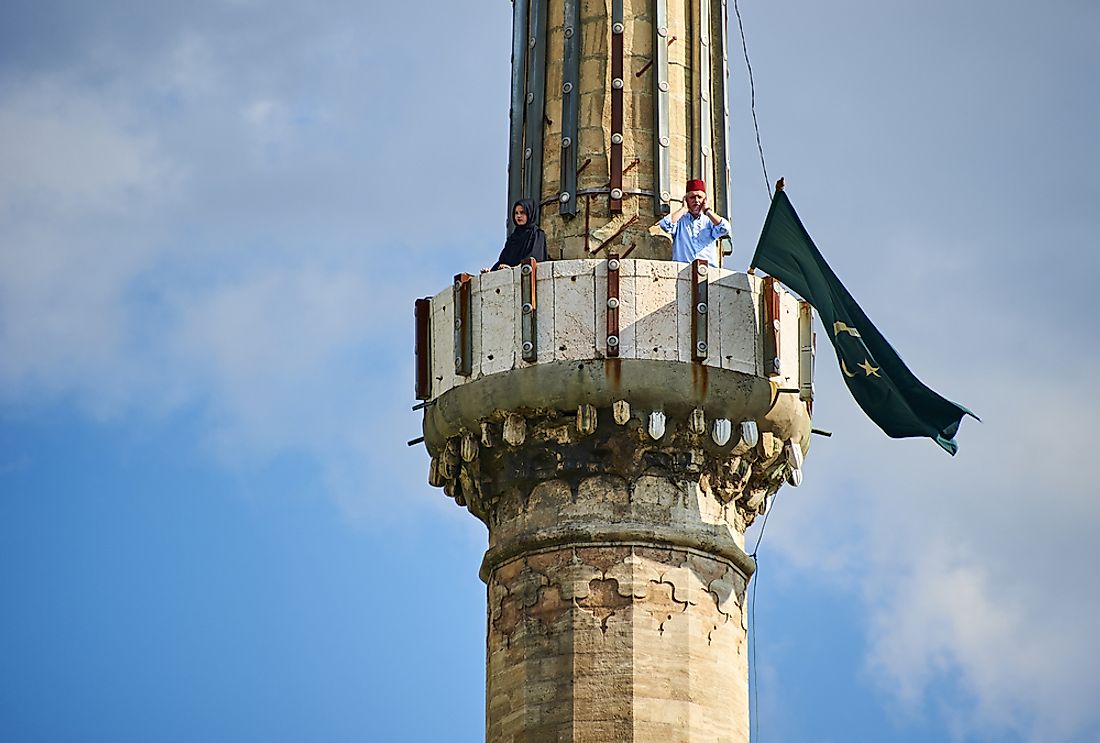What is a Muezzin?

Calls to Prayer
A Muezzin is a mosque (Islamic place of worship) official who recites the call for Muslims to come to prayer five times a day. Muslims offer these namaaz prayers at dawn, noon, early evening, sunset, and nightfall. The human voice to summon worshipers is the Islamic equivalent of the Jewish trumpet and the bell of Christians. The muezzin’s is an important post because the faithful depend on him for their prayer schedule.
Making the Call
In earlier times, the muezzin used to stand at the door or at the side of the mosque from where people could hear his call (known as adhan or azaan). The muezzin faces each of the four cardinal directions in turn, turning to the east, west, north, and south as he calls out "Allah is most great. I testify that there is no god but Allah. I testify that Mohammad is the prophet of Allah. Come to prayer; come to salvation. Allah is most great." Despite facing all directions, most of the adhan is recited facing the qiblah, which is the direction of the the most sacred mosque, the Ka’bah in Mecca.
Embracing Technology
When minarets became a standard architectural feature of mosques, the muezzin called out from the tops of the minarets. In cities, the office of the muezzin was often given to blind men, who would be unable to see into people’s houses below, and thus ensure people’s privacy. With the advent of tape recorders and other audio technology thereafter, modern mosques have installed loudspeakers on the top of the minarets, while the muezzin recites the adhan from below through a microphone, allowing the adhan to be heard at far distances without the muezzin having to climb to the top of the minaret. Now, even recordings of the call are played to take advantage of the technology.
The Adhan as an Art Form
The first muezzin ever was Bilal ibn Ribah, who initially walked the streets to remind the believers it was prayer time. He was a trusted companion of the greatest Muslim prophet, and was chosen for the task by the very same Mohammed himself. He was born a slave, but was emancipated due to the Islamic position on slavery. He was known for his beautiful voice, which may have been the reason for his selection as the first muezzin. Ribah’s elevated stature during the birth of Islam points to the emphasis on plurality and racial equality in the foundations of the religion.
A muezzin is a professional chosen for his good character and booming voice. He is not a cleric, but is the equivalent of a Christian verger. The call of the muezzin is a cultural art, which is reflected in the melodious composition and rendering of the adhan. Turkey holds an annual competition to acknowledge and reward the best muezzins in the country.
When Abdul Karim Moazzen Zadeh Ardabil, a Shia muezzin from Iran, summoned the faithful, his azaan was recorded and broadcast on radio. From 1943 to 1947, he conducted a morning radio program out of the Imam Mosque in Tehran. After his death, his son Rahim Moazenzadeh succeeded him. His famous prayer call is in the Bayat Turk style of Persian music. It was performed from the studio of the radio station in 1955. For rendering this azaan, Moazenzadeh examined various styles of music before honing in on the Bayat Turk sound out of “spiritual pride”. This same azaan can still be heard on Shia Muslim radio and television.











